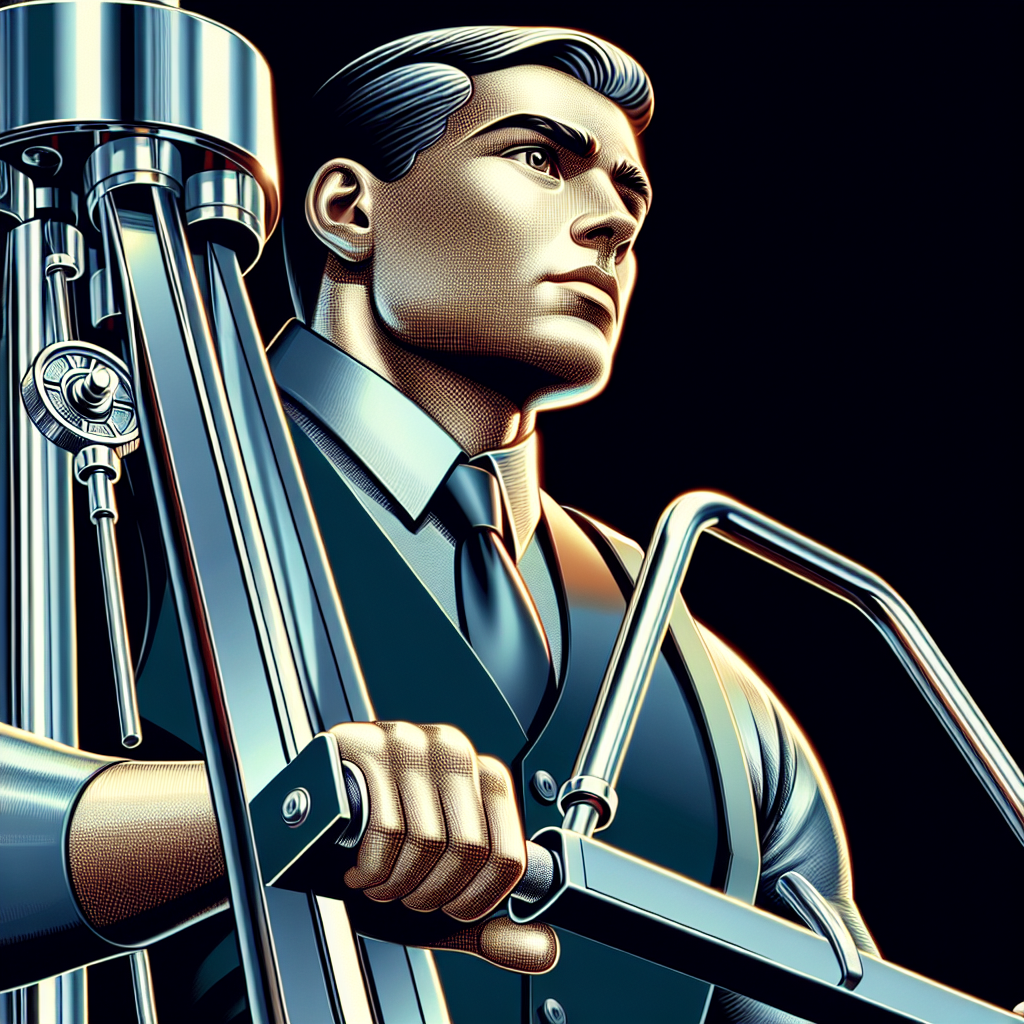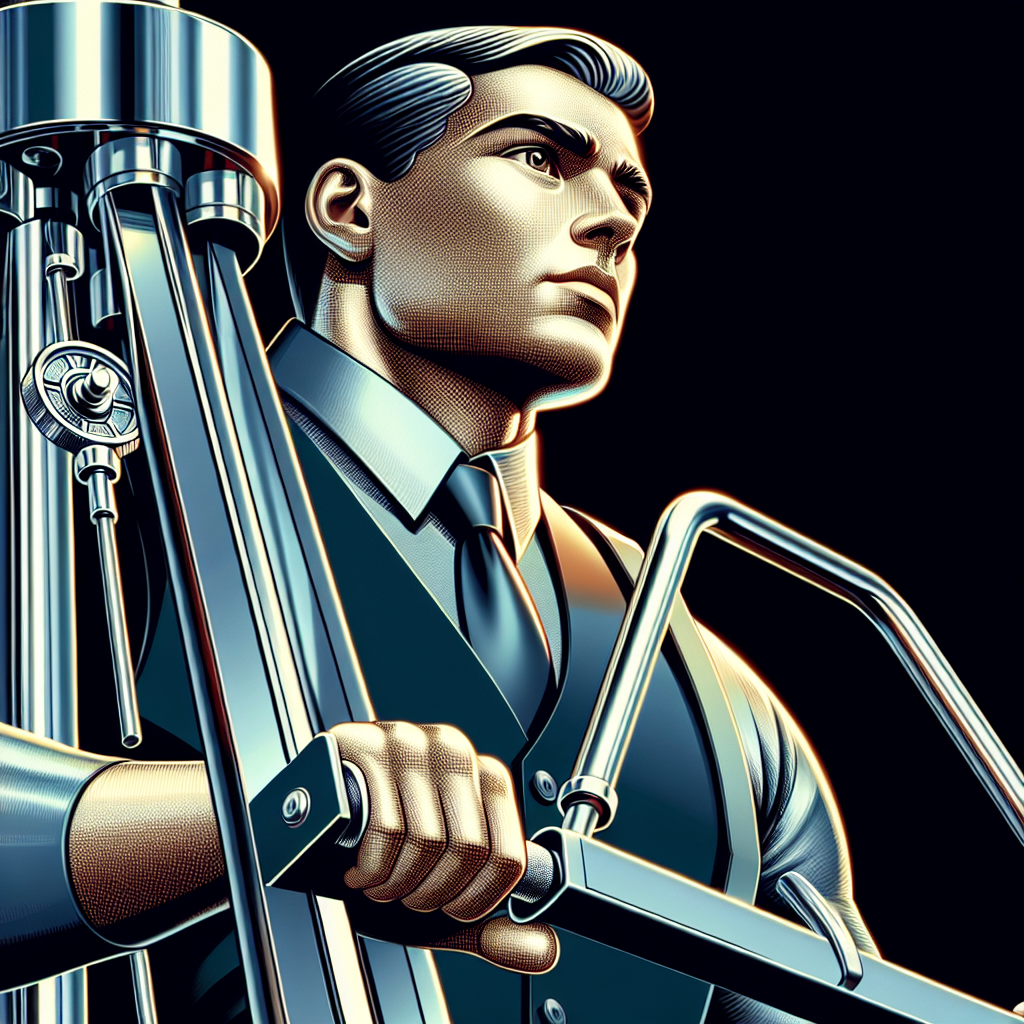I am here to discuss the topic of effective lower back exercises using gym machines. In this article, I will explore various modern gym machines that can be used for lower back exercises, their costs, and provide a comparison of each machine’s effectiveness. By examining these machines, individuals can gain a better understanding of how to effectively target and strengthen their lower back muscles in a gym setting. Through this analysis, readers will be equipped with the knowledge to make informed decisions about which gym machines are the most suitable for their lower back exercise needs.
Effective Lower Back Exercises Using Gym Machines
The lower back is an essential area of the body that plays a crucial role in everyday movements and overall stability. Strengthening this region is vital for maintaining good posture, preventing injuries, and enhancing athletic performance. While there are various exercises that target the lower back, gym machines offer a convenient and effective way to specifically work on this area. In this article, I will explore ten different gym machines and their corresponding lower back exercises, discussing their benefits and proper execution.

1. Leg Press Machine
1.1. Seated Leg Press
The seated leg press machine is primarily used to target the lower body, including the quadriceps, hamstrings, and glutes. Although its main focus is not the lower back, incorporating the seated leg press into a workout routine can still provide benefits to this area. When performing the seated leg press, I engage my core and maintain proper posture throughout the movement, which helps activate the muscles in my lower back. This exercise helps develop overall lower body strength and stability, indirectly contributing to a strong lower back.
1.2. Single-Leg Press
The single-leg press is a variation of the traditional leg press that places greater emphasis on balance and stability. By working one leg at a time, this exercise not only targets the quadriceps and glutes but also activates the lower back muscles to maintain stability throughout the movement. Incorporating the single-leg press into a lower body workout routine can help strengthen the lower back while also improving overall leg strength and stability.
1.3. Sumo Leg Press
The sumo leg press, also known as the wide-stance leg press, is a variation of the leg press exercise that targets the inner thighs (adductors) as well as the glutes and quadriceps. While the primary focus of this exercise is on the lower body, it also engages the lower back muscles to stabilize the spine and pelvis during the movement. The sumo leg press can be a valuable addition to a lower body routine, providing a comprehensive workout for both the lower back and lower body muscles.
2. Cable Machine
2.1. Cable Row
The cable row is an excellent exercise for targeting the muscles of the upper back, including the rhomboids, traps, and lats. While it primarily focuses on the upper back, the cable row also engages the lower back muscles to stabilize the spine during the movement. By keeping the core engaged and maintaining proper posture, I can effectively work my lower back while performing this exercise. The cable row is a versatile exercise that can be modified to target different areas of the back, providing an efficient way to strengthen the entire posterior chain, including the lower back.
2.2. Standing Cable Pull-Through
The standing cable pull-through is a unique exercise that targets the glutes, hamstrings, and lower back. By utilizing the cable machine, I can apply tension on my posterior chain muscles while maintaining proper form and engaging the core. This exercise involves a hip hinge motion, allowing me to work the lower back muscles while also targeting the glutes and hamstrings. The standing cable pull-through is a compound movement that engages multiple muscle groups, making it an effective exercise for developing overall posterior chain strength and stability.
2.3. Cable Deadlift
The cable deadlift is a variation of the traditional barbell deadlift that utilizes the cable machine for resistance. This exercise primarily targets the glutes, hamstrings, and lower back muscles. By keeping the core engaged and maintaining proper form, I can effectively work the muscles in my lower back while performing the cable deadlift. This exercise offers the advantage of providing constant tension throughout the movement, activating the lower back muscles in a controlled manner. Incorporating the cable deadlift into a workout routine can help strengthen the lower back while also enhancing overall posterior chain development.

3. Lat Pulldown Machine
3.1. Wide Grip Lat Pulldown
The wide grip lat pulldown is a popular exercise that primarily targets the latissimus dorsi, or the “lats,” which are the large muscles that give the back its wide appearance. While the focus of this exercise is on the upper back and arms, it also engages the lower back muscles to stabilize the body during the movement. By maintaining proper posture and engaging the core, I can effectively work my lower back while performing the wide grip lat pulldown. This exercise is beneficial for overall back strength and development, indirectly contributing to a strong lower back.
3.2. Close Grip Lat Pulldown
The close grip lat pulldown is a variation of the wide grip lat pulldown that places greater emphasis on the middle back, biceps, and forearms. While the primary focus of this exercise is on the upper back, it also engages the lower back muscles to maintain stability throughout the movement. By keeping the core engaged and maintaining proper form, I can effectively target the muscles of my lower back while performing the close grip lat pulldown. This exercise is particularly beneficial for developing back strength and stability, indirectly benefiting the lower back muscles.
3.3. Reverse Grip Lat Pulldown
The reverse grip lat pulldown is another variation of the lat pulldown exercise that primarily targets the upper back, biceps, and forearms. By utilizing an underhand grip, I can effectively engage the lower back muscles while performing this exercise. The reverse grip lat pulldown requires core engagement and proper posture throughout the movement to stabilize the spine. In addition to its focus on the upper back, this exercise helps strengthen the muscles of the lower back, contributing to overall back strength and stability.
4. Smith Machine
4.1. Smith Machine Good Morning
The Smith machine good morning is an exercise that primarily targets the hamstrings, glutes, and lower back muscles. The unique design of the Smith machine allows for controlled movement and added stability, particularly beneficial when performing exercises that involve the lower back. By maintaining proper posture, engaging the core, and using appropriate weights, I can effectively work on my lower back while performing the Smith machine good morning. This exercise offers the advantage of providing continuous tension on the posterior chain muscles, helping to develop strength and stability in the lower back.
4.2. Smith Machine Romanian Deadlift
The Smith machine Romanian deadlift, also known as the Smith machine stiff-legged deadlift, is an exercise that primarily targets the hamstrings, glutes, and lower back. Similar to the Smith machine good morning, this exercise utilizes the stability of the Smith machine to focus on proper form and controlled movement. By keeping the core engaged and maintaining proper posture, I can effectively engage the muscles of my lower back while performing the Smith machine Romanian deadlift. This exercise offers a practical alternative to the traditional barbell Romanian deadlift, providing the benefits of controlled movement and stability.
4.3. Smith Machine Hip Thrust
The Smith machine hip thrust is an exercise that primarily targets the glutes, hamstrings, and lower back muscles. By utilizing the Smith machine, I can safely and effectively perform this movement with added stability. By keeping the core engaged, maintaining proper posture, and using appropriate weights, I can activate the muscles in my lower back while performing the Smith machine hip thrust. This exercise provides a comprehensive workout for the posterior chain muscles, including the lower back, contributing to overall strength and stability.

5. Back Extension Machine
5.1. Traditional Back Extension
The traditional back extension machine is specifically designed to target the muscles of the lower back. By adjusting the machine to the appropriate height and positioning myself correctly, I can effectively engage the muscles in my lower back while performing the back extension exercise. The key to this exercise is maintaining proper form, engaging the core, and avoiding excessive hyperextension of the spine. The traditional back extension is an excellent isolation exercise for the lower back muscles, helping to strengthen and stabilize this area.
5.2. Reverse Back Extension
The reverse back extension is a variation of the traditional back extension exercise that primarily targets the glutes, hamstrings, and lower back muscles. By positioning myself face-down on the back extension machine and utilizing the glutes and hamstrings to raise my legs, I can effectively engage the muscles in my lower back. This exercise offers a functional way to strengthen the posterior chain muscles, including the lower back, contributing to overall stability and strength.
5.3. Russian Twist with Back Extension
The Russian twist with back extension is a combination exercise that targets the muscles of the lower back, obliques, and abdominals. By utilizing the back extension machine and performing the Russian twist movement, I can engage multiple muscle groups simultaneously. This exercise emphasizes rotational stability and core strength while also providing a comprehensive workout for the lower back. The Russian twist with back extension is a challenging exercise that requires proper form and core engagement but offers significant benefits for overall strength and stability.
6. Glute Ham Developer (GHD) Machine
6.1. GHD Back Extension
The GHD back extension is an exercise specifically designed to target the muscles of the lower back. By utilizing the GHD machine, I can safely and effectively perform this movement with added stability. By keeping the core engaged, maintaining proper form, and using appropriate weights, I can activate the muscles in my lower back while performing the GHD back extension. This exercise provides a comprehensive workout for the lower back muscles, helping to strengthen and stabilize this area.
6.2. GHD Russian Twist
The GHD Russian twist is a variation of the traditional Russian twist exercise that specifically targets the muscles of the lower back, obliques, and abdominals. By utilizing the GHD machine and performing the Russian twist movement, I can engage multiple muscle groups simultaneously, with a particular focus on the lower back. This exercise emphasizes rotational stability and core strength while also providing a comprehensive workout for the lower back. The GHD Russian twist is a challenging exercise that requires proper form and core engagement, contributing to overall strength and stability.
6.3. GHD Hip Extension
The GHD hip extension is an exercise that primarily targets the glutes, hamstrings, and lower back muscles. By utilizing the GHD machine, I can safely and effectively perform this movement with the added stability. By keeping the core engaged, maintaining proper form, and using appropriate weights, I can activate the muscles in my lower back while performing the GHD hip extension. This exercise provides a comprehensive workout for the posterior chain muscles, including the lower back, contributing to overall strength and stability.

7. Roman Chair
7.1. Roman Chair Hyperextension
The Roman chair hyperextension is a classic exercise that primarily targets the muscles of the lower back and posterior chain. By positioning myself on the Roman chair and maintaining proper form, I can effectively work the muscles in my lower back while performing the hyperextension movement. This exercise requires core engagement, proper posture, and controlled movement to maximize its benefits. The Roman chair hyperextension is an excellent exercise for strengthening and stabilizing the lower back muscles, contributing to overall back strength.
7.2. Single-Leg Roman Chair Hyperextension
The single-leg Roman chair hyperextension is a variation of the traditional Roman chair hyperextension that places greater emphasis on balance and stability. By working one leg at a time, this exercise not only targets the muscles of the lower back but also activates the core and leg muscles. By maintaining proper form, engaging the core and leg muscles, and performing the movement gradually, I can effectively engage the muscles in my lower back while improving overall balance and stability. The single-leg Roman chair hyperextension is a challenging exercise that offers significant benefits for strengthening the lower back muscles.
7.3. Russian Twist on Roman Chair
The Russian twist on the Roman chair is a combination exercise that targets the muscles of the lower back, obliques, and abdominals. By utilizing the Roman chair and performing the Russian twist movement, I can engage multiple muscle groups simultaneously. This exercise emphasizes rotational stability, core strength, and coordination while also providing a comprehensive workout for the lower back. The Russian twist on the Roman chair is a challenging exercise that requires proper form, core engagement, and balance, but offers significant benefits for overall strength and stability.
8. Reverse Hyperextension Machine
8.1. Reverse Hyperextension
The reverse hyperextension is an exercise specifically designed to target the muscles of the lower back and glutes. By utilizing the reverse hyperextension machine, I can safely and effectively perform this movement with added stability. By keeping the core engaged, maintaining proper form, and using appropriate weights, I can activate the muscles in my lower back while performing the reverse hyperextension. This exercise provides a comprehensive workout for the lower back muscles, helping to strengthen and stabilize this area.
8.2. Single-Leg Reverse Hyperextension
The single-leg reverse hyperextension is a variation of the reverse hyperextension exercise that places greater emphasis on balance and stability. By working one leg at a time, this exercise not only targets the muscles of the lower back and glutes but also activates the core and leg muscles. By maintaining proper form, engaging the core and leg muscles, and performing the movement gradually, I can effectively engage the muscles in my lower back while improving overall balance and stability. The single-leg reverse hyperextension is a challenging exercise that offers significant benefits for strengthening the lower back muscles.
8.3. Weighted Reverse Hyperextension
The weighted reverse hyperextension is a progressive variation of the reverse hyperextension exercise that involves adding weights for increased resistance. By utilizing the reverse hyperextension machine and attaching weights, I can safely and effectively challenge the muscles in my lower back. This exercise provides an opportunity to progressively increase the workload on the lower back muscles, contributing to strength and stability. By maintaining proper form, engaging the core, and gradually increasing the weights used, I can effectively stimulate the lower back muscles and enhance overall posterior chain development.

9. Seated Row Machine
9.1. Seated Cable Row
The seated cable row is an exercise that primarily targets the muscles of the upper back, including the rhomboids, traps, and lats. While its primary focus is on the upper back, the seated cable row also engages the lower back muscles to stabilize the body during the movement. By maintaining proper posture and engaging the core, I can effectively work the muscles in my lower back while performing the seated cable row. This exercise is beneficial for overall back strength and development, indirectly benefiting the lower back muscles.
9.2. Close Grip Seated Row
The close grip seated row is a variation of the seated cable row exercise that targets the middle back, biceps, and forearms. While its primary focus is on the upper back, the close grip seated row also engages the lower back muscles to maintain stability throughout the movement. By keeping the core engaged and maintaining proper form, I can effectively target the muscles of my lower back while performing the close grip seated row. This exercise contributes to overall back strength and stability, indirectly benefiting the lower back muscles.
9.3. Wide Grip Seated Row
The wide grip seated row is another variation of the seated cable row exercise that targets the upper back, biceps, and forearms. While its primary focus is on the upper back, the wide grip seated row also engages the lower back muscles to stabilize the body during the movement. By maintaining proper posture, engaging the core, and using appropriate weights, I can effectively target the muscles of my lower back while performing the wide grip seated row. This exercise contributes to overall back strength and development, indirectly benefiting the lower back muscles.
10. T-Bar Row Machine
10.1. T-Bar Row
The T-bar row is an exercise that primarily targets the upper back, including the rhomboids, traps, and lats. While its focus is on the upper back, the T-bar row also engages the lower back muscles to stabilize the body during the movement. By maintaining proper posture, engaging the core, and using appropriate weights, I can effectively work the muscles in my lower back while performing the T-bar row. This exercise contributes to overall back strength and development, indirectly benefiting the lower back muscles.
10.2. Single-Arm T-Bar Row
The single-arm T-bar row is a variation of the T-bar row exercise that places greater emphasis on balance and stability. By working one arm at a time, this exercise not only targets the upper back but also engages the core and leg muscles for stabilization. By maintaining proper form, engaging the core and leg muscles, and performing the movement gradually, I can effectively engage the muscles in my lower back while improving overall balance and stability. The single-arm T-bar row is a challenging exercise that offers significant benefits for strengthening the lower back muscles.
10.3. Landmine T-Bar Row
The landmine T-bar row is another variation of the T-bar row exercise that specifically targets the upper back, biceps, and forearms. By utilizing the landmine attachment, I can perform this exercise with added stability and control. While its primary focus is on the upper back, the landmine T-bar row also engages the lower back muscles to stabilize the body during the movement. By maintaining proper posture, engaging the core, and using appropriate weights, I can effectively target the muscles of my lower back while performing the landmine T-bar row. This exercise contributes to overall back strength and development, indirectly benefiting the lower back muscles.
In conclusion, incorporating these gym machines into a lower back workout routine offers a comprehensive approach to strengthening and stabilizing the lower back muscles. By utilizing the benefits of each machine and performing the exercises with proper form and technique, individuals can effectively target the muscles in the lower back while also engaging other muscle groups. Whether using the leg press machine, cable machine, lat pulldown machine, Smith machine, back extension machine, Glute Ham Developer machine, Roman chair, reverse hyperextension machine, seated row machine, or T-bar row machine, there are numerous options available to effectively work the lower back. Remember to use appropriate weights, maintain proper form, and engage the core throughout each exercise to maximize the benefits and reduce the risk of injury.



One thought on “Effective Lower Back Exercises Using Gym Machines”